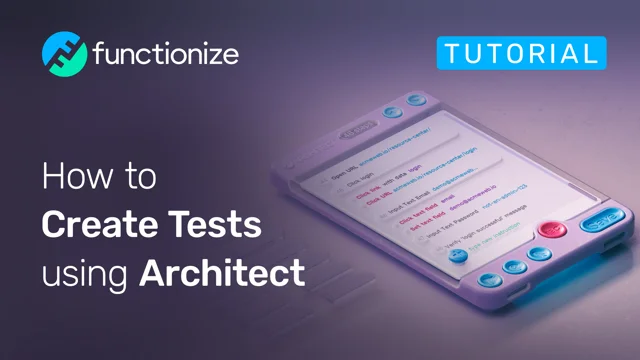To create automated tests using Architect, follow these steps:

- Go to the Functionize website and log in to your account.
- Click the “Architect” tab.
- Click the “+” button to create a new test case.
- Enter a name for the test case and select the project that you want to add the test case to.
- Click the “Create” button.
- To record the actions that you want to automate, click the “Record” button.
- Navigate to the page that you want to automate.
- Perform the actions that you want to automate.
- Click the “Stop Recording” button.
- Review the recorded actions and make any necessary edits.
- Click the “Save” button.
You can also create automated tests by writing code. To do this, click the “Code” tab in Architect.
Once you have created your automated test, you can execute it by clicking the “Run” button.
Here are some tips for creating automated tests using Architect:
- Use descriptive names for your test cases and test steps. This will make your test cases easier to understand and maintain.
- Use variables to store data that is used in multiple test steps. This will make your test cases more reusable.
- Use assertions to verify the expected behavior of the application under test. This will help you to identify any unexpected behavior.
- Organize your test cases into logical groups. This will make it easier to find and run the test cases that you need.
- Use Functionize’s built-in library of actions to automate common tasks. This will save you time and effort.
Functionize also offers a number of resources to help you learn how to use Architect to create automated tests. These resources include tutorials, documentation, and support forums.
Here are some tips for creating tests with Architect:
- Use descriptive names for your test cases and test steps. This will make your test cases easier to understand and maintain.
- Use variables to store data that is used in multiple test steps. This will make your test cases more reusable.
- Use assertions to verify the expected behavior of the application under test. This will help you to identify any unexpected behavior.
- Organize your test cases into logical groups. This will make it easier to find and run the test cases that you need.
- Use Functionize’s built-in library of actions to automate common tasks. This will save you time and effort.
Functionize also offers a number of resources to help you learn how to use Architect to create tests. These resources include tutorials, documentation, and support forums.
Overall, Architect is a powerful tool that can be used to create tests for a wide variety of applications.
Here are some examples of how Architect can be used to create tests:
- Web testing: Architect can be used to create tests for web applications. For example, you can use Architect to create tests that verify that a login page works correctly or that a product page displays the correct information.
- API testing: Architect can be used to create tests for APIs. For example, you can use Architect to create tests that verify that an API returns the correct data or that an API endpoint works correctly.
- Mobile testing: Architect can be used to create tests for mobile applications. For example, you can use Architect to create tests that verify that a mobile app launches correctly or that a specific feature in the mobile app works correctly.
Architect is a versatile tool that can be used to create tests for a wide variety of applications. By following the tips above, you can create tests that are efficient, effective, and easy to maintain.

Leave a Comment